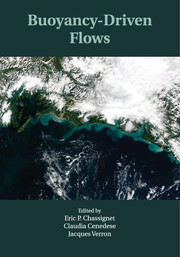Book contents
- Frontmatter
- Contents
- List of Contributors
- Introduction
- 1 Gravity currents – theory and laboratory experiments
- 2 Theory of oceanic buoyancy-driven flows
- 3 Buoyancy-forced circulation and downwelling in marginal seas
- 4 Buoyant coastal currents
- 5 Overflows and convectively driven flows
- 6 An ocean climate modeling perspective on buoyancy-driven flows
- 7 Buoyancy-driven currents in eddying ocean models
- 8 Atmospheric buoyancy-driven flows
- 9 Volcanic flows
- 10 Gravity flow on steep slope
- Index
- Plate section
- References
2 - Theory of oceanic buoyancy-driven flows
Published online by Cambridge University Press: 05 April 2012
- Frontmatter
- Contents
- List of Contributors
- Introduction
- 1 Gravity currents – theory and laboratory experiments
- 2 Theory of oceanic buoyancy-driven flows
- 3 Buoyancy-forced circulation and downwelling in marginal seas
- 4 Buoyant coastal currents
- 5 Overflows and convectively driven flows
- 6 An ocean climate modeling perspective on buoyancy-driven flows
- 7 Buoyancy-driven currents in eddying ocean models
- 8 Atmospheric buoyancy-driven flows
- 9 Volcanic flows
- 10 Gravity flow on steep slope
- Index
- Plate section
- References
Summary
General Considerations and a Laboratory Example
Introduction
Both the atmosphere and ocean are rotating and stratified, and for large-scale motions (an attribute that needs careful definition), both are important in shaping the dynamics. Both the mean circulation, whose scales usually reflect the forcing, and the inevitable eddy fields that result from the instability of those motions are determined by the effects of rotation and stratification. In this chapter, I am going to examine some particular aspects of the buoyancy-driven motion of a rotating stratified fluid with an eye to oceanic phenomena, in particular the important question of the relationship between the vertical motion and the surface buoyancy forcing. This question is of particular importance in the discussion of the oceans' role in climate since a key issue in delineating that role is how and where the sinking of surface-cooled water takes place. It should not be surprising that the presence of rotation and, in particular, the variation of the local normal component of that rotation (the beta-effect) renders the association of forcing and sinking sometimes nonintuitive. In sections 2.2 and 2.3, we will examine the nature of the circulation in simple models with an eye to uncovering in easily understandable circumstances the underlying physics that determines the structure of the vertical motion. Of course, the nature of the horizontal motion is coupled to the vertical motion and will be discussed as well.
- Type
- Chapter
- Information
- Buoyancy-Driven Flows , pp. 52 - 117Publisher: Cambridge University PressPrint publication year: 2012



